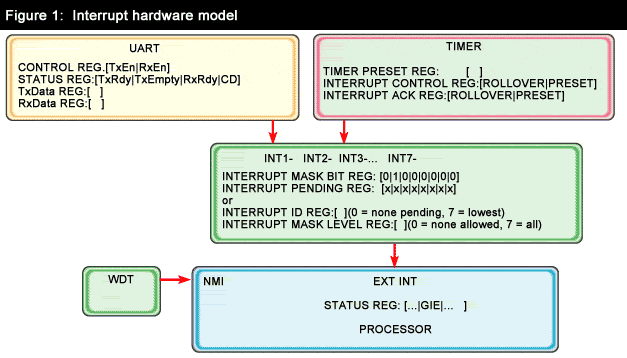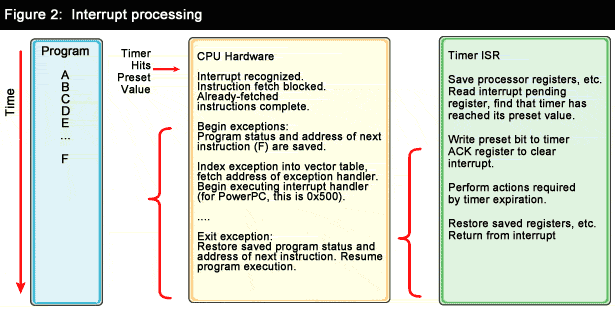![]() Additional Resources: Beginner's Corner
Additional Resources: Beginner's Corner
|
|
 |
Introduction to
Interrupts
By
Russell Massey, Embedded Systems Programming
Jun 1, 2001 (11:54 AM)
URL:
http://www.embedded.com/story/OEG20010518S0075
Normal execution of a
given software application is contained within the bounds of one program, or
instruction stream. Such execution is provable, as well as traceable. However,
system designers and implementers also have to understand how breaks in program
flow occur, and how they may affect the running program. Flow breaks fall into
two general classes:
This article explains how an interrupt is handled by the processor and
software.
Why interrupt?
As a system's functional requirements and the size of the software grow, it
becomes more difficult to ensure that time-critical items (such as capturing
incoming data before it is overwritten by the hardware) are performed properly.
We can approach this dilemma with a faster processor (more cost, more heat, and
more radiated noise), or we can separate the time-critical functions from the
others and execute them in a prioritized manner. Interrupts form the basis for
this separation. The non-time-critical functions continue to execute as quickly
as they can (within the main loop), but time-critical functions are executed on
demand-in response to interrupts from the hardware.
Hardware
When a device asserts its interrupt request signal, it must be processed in
an orderly fashion. All CPUs, and many devices, have some mechanism for
enabling/disabling interrupt recognition and processing:
Figure
1 shows an interrupt controller, two devices capable of producing
interrupts, a processor, and the interrupt-related paths among them. The
interrupt controller multiplexes multiple input requests into one output. It
shows which inputs are active and allows individual inputs to be masked.
Alternatively, it prioritizes the inputs, shows the highest active input, and
provides a mask for inputs below a given level. The processor status register
has a global interrupt enable flag bit. In addition, a watchdog timer is
connected to the non-maskable interrupt input.
The interrupt software associated with a specific device is known as its
interrupt service routine (ISR), or handler.
Software
Some older CPUs routed all interrupts to a single ISR. Upon recognizing an
interrupt, the CPU saved some state information and started execution at a fixed
location. The ISR at that location had to poll the devices in priority order to
determine which one required service. However, the basic process of interrupt
handling is the same as in the more complex case.
Most modern CPUs use the same general mechanism for processing exceptions,
traps, and interrupts: an interrupt vector table. Some CPU vector tables contain
only the address of the code to be executed. In most cases, a specific ISR is
responsible for servicing each interrupting device and acknowledging, clearing,
and rearming its interrupt; in some cases, servicing the device (for example,
reading data from a serial port) automatically clears and rearms the interrupt.
Interrupts may occur at any time, but the CPU does not instantly recognize
and process them immediately. First, the CPU will not recognize a new interrupt
while interrupts are disabled. Second, the CPU must, upon recognition, stop
fetching new instructions and complete those still in progress. Because the
interrupt is totally unrelated to the running program it interrupts, the CPU and
ISR work together to save and restore the full state of the interrupted program
(stack, flags, registers, and so on). The running program is not affected by the
interruption, although it takes longer to execute. The hardware and software
flow for a timer interrupt is shown in Figure
2.
Many interrupt controllers provide a means of prioritizing interrupt sources,
so that, in the event of multiple interrupts occurring at (approximately) the
same time, the more time-critical ones are processed first. These same systems
usually also provide for prioritized interrupt handling, a means by which a
higher-priority interrupt can interrupt the processing of a lower-priority
interrupt. This is called interrupt nesting. In general, the ISR should only
take care of the time-critical portion of the processing, then, depending on the
complexity of the system, it may set a flag for the main loop, or use an
operating system call to awaken a task to perform the non-time-critical portion.
Latency
The interrupt latency is the interval of time measured from the instant an
interrupt is asserted until the corresponding ISR begins to execute. The
worst-case latency for any given interrupt is a sum of many things, from longest
to shortest:
We can see how higher-priority interrupts can have much lower latencies. In
simple cases, latency can be calculated from instruction times, but many modern
systems with 32-bit CPUs, caches, and multiple interrupt sources, are far too
complex for exact latency calculations. Interrupt latency must be considered at
design time, whenever responsiveness matters.
Russell Massey is a staff engineer with Honeywell Industrial Control.
He has worked in the computer field for over 25 years. His e-mail address is russell.massey@honeywell.com.


Copyright 2002 © CMP Media LLC
![]()
|
|